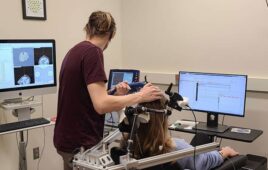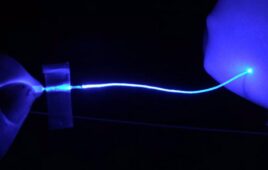
Zebrafish neurons projecting to the brain (green). One neuron expresses a light-activatable enzyme (red). Scientist were able to stimulate the regeneration of injured neurons using optogenetics. (Credit: Helmholtz Zentrum München)
Scientists at Helmholtz Zentrum München have succeeded in stimulating the regeneration of injured neurons in living fish by the use of light. To this end, they employed so-called Optogenetics, i.e. light inducible protein activation. The results have recently been published in the journal ‘Current Biology’.
The nervous system is built to last a lifetime, but diverse diseases or environmental insults can overpower the capacity of neurons to maintain function or to repair after trauma. A team led by Dr. Hernán López-Schier, head of the Research Unit Sensory Biology and Organogenesis at Helmholtz Zentrum München, now succeeded in promoting the repair of an injured neural circuit in zebrafish.
Key for the researchers’ success was the messenger molecule cAMP, which is produced by an enzyme called adenylyl cyclase. For their experiment, the scientist used a special form of this enzyme which is inducible by blue light. Therefore, the scientists are able to specifically modulate the production of cAMP in cells expressing this enzyme by the use of blue light.*
The researchers used this system in zebrafish larvae** which had interrupted sensory lateralis nerves***. “However, when blue light was shone on severed nerves that expressed a photoactivatable adenylyl cyclase, their repair was dramatically increased,” remembers PhD student Yan Xiao who is the first author of the study. “While untreated nerve terminals only made synapses again in five percent of the cases, about 30% did after photostimulation.” In simple terms: the scientists were able to stimulate the repair of a neuronal circuit by elevating cAMP with blue light.
“Optogenetics have revolutionized neurobiology, since the method has already been used to modify for instance the electrical activity of neurons. However, our results show for the first time how the repair of a complex neural circuit in a whole animal can be promoted remotely by the use of light”, explains López-Schier.
But the head of the study thinks that this is only the beginning: “Our results are a first step. Now we would like to investigate, whether these results can be extrapolated beyond single neurons in zebrafish, to more complex neuronal circuits of higher animals.” The scientist could think of using this method for future therapeutic approaches for the treatment of neuropathies like those occurring in the wake of Diabetes and other diseases.
*Optogenetics: As the name indicates, this cutting-edge technology combines elements of Optics and Genetics. Scientists make use of proteins which are sensitive to certain wavelengths of light. These are brought into the target cells with certain genetic methods. The so treated cells then change their respective phenotype depending on the exposure to light.
**Larvae of zebrafish are particularly well suited for optogenetic approaches, since their skin in transparent/translucent. Thus, the light can reach the respective target cells easily.
***These nerves normally communicate external sensory signals to the brain, but cannot normally repair after injury.




